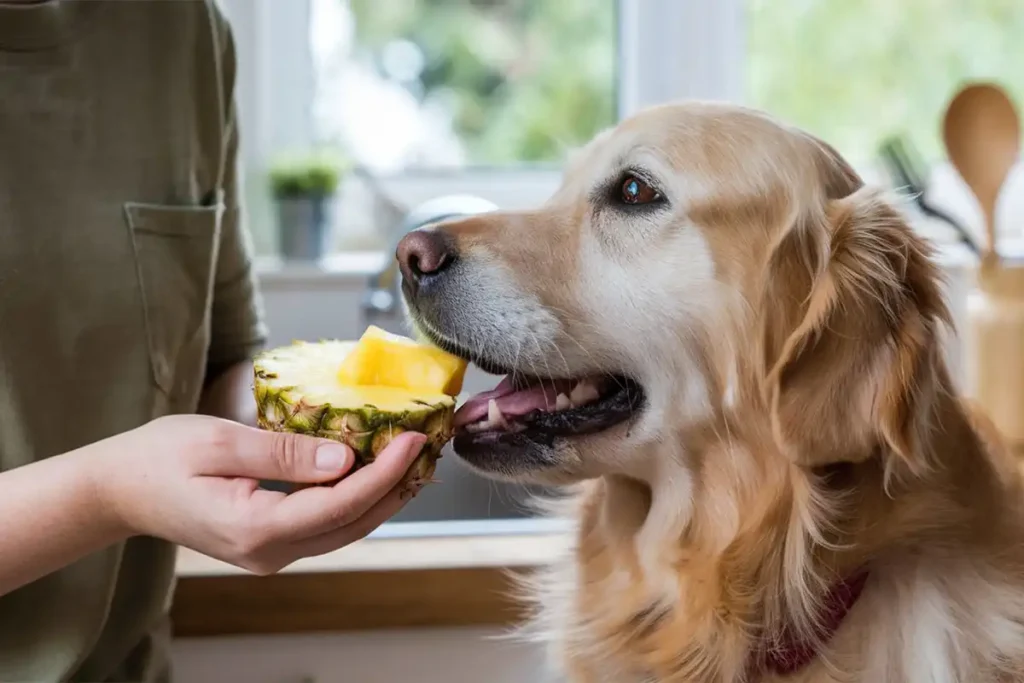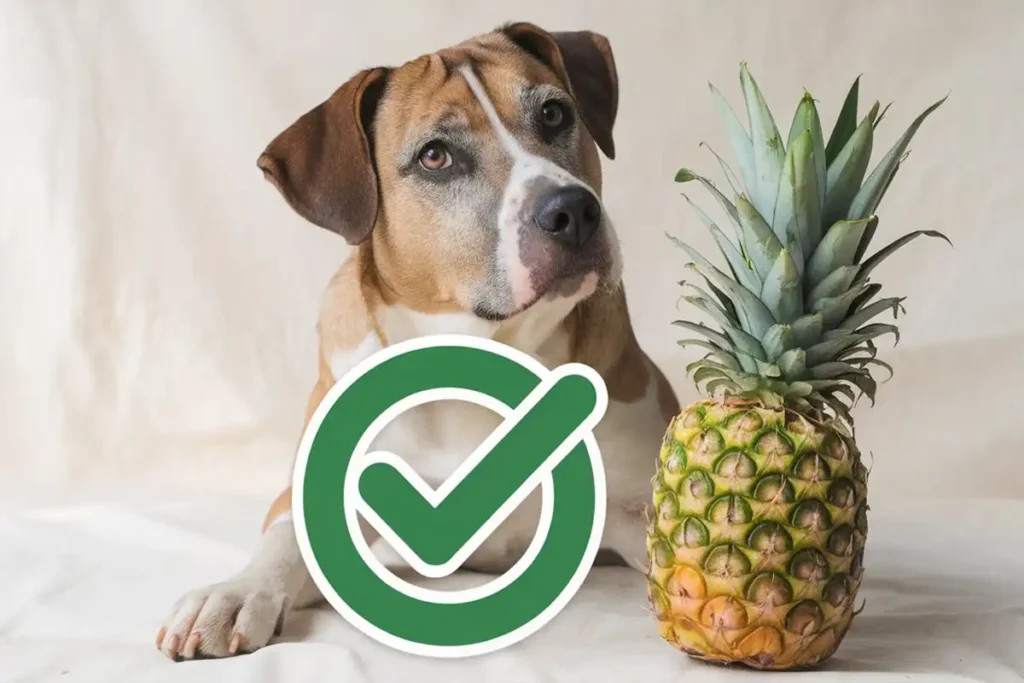As a loving dog owner, you always want what’s best for your furry friend—especially when it comes to their diet. So, when you’re enjoying a juicy slice of pineapple on a warm day, it’s natural to wonder: can dogs eat pineapple too? The good news is, you’re not alone in asking this question. Many pet parents are curious about which fruits are safe for dogs and which ones might pose a risk.
In this guide, we’re diving deep into everything you need to know about dogs and pineapple. From the nutritional benefits and potential risks to how to safely serve it and even fun treat ideas, we’ve got you covered. By the end, you’ll know whether pineapple deserves a spot in your pup’s snack rotation—and exactly how to make it a healthy, tail-wagging treat.
Is Pineapple Safe for Dogs? The Quick Answer
Can Dogs Eat Pineapple Raw?
You might be munching on a juicy slice of pineapple and wonder if your dog can enjoy it too. The answer is yes—dogs can eat pineapple raw, and it’s actually one of the healthiest ways to serve it. Fresh pineapple is rich in vitamin C, fiber, and a digestive enzyme called bromelain, which can help support your dog’s immune system and gut health. To keep it safe for your dog, first take off the prickly skin and the hard middle part. Then, cut the soft part into small pieces that your dog can easily eat. Avoid adding seasonings, sugar, or canned versions that often contain harmful additives. Introduce pineapple slowly to see how your pup reacts, and always feed it in moderation.
Are There Any Risks to Feeding Pineapple to Dogs?
Feeding your dog pineapple can be a great way to sneak in extra nutrients, but it’s important to know when this fruit might cause problems. Pineapple contains natural sugars, which in large amounts can upset your dog’s stomach or contribute to weight gain, especially in smaller or less active breeds. Some dogs may also experience digestive discomfort like gas or loose stools if they eat too much at once. Don’t give the hard middle part or the tough outside skin of the pineapple to eat. They can be dangerous because they might choke someone or cause a blockage in their stomach. To safely feed pineapple to your dog, start with a few small pieces and monitor their reaction. When you keep portions small and preparation safe, dogs can eat pineapple without trouble.
Sugar in Pineapple and Dogs: What to Watch For
Pineapple has a sweet, tropical flavor that many dogs find irresistible—but it’s the sugar that raises a red flag. Even though the sugar in pineapple is natural, your dog’s system processes it differently than yours. Too much sugar can quickly lead to weight gain, upset stomach, or even long-term issues like diabetes or tooth decay. When choosing treats for your dog, avoid canned pineapple completely, as it usually contains added sugars or syrup that can spike their blood sugar levels. Stick with fresh pineapple in small, controlled amounts. Dogs can eat pineapple safely, but only when you’re mindful of the sugar content and treat it as an occasional snack—not an everyday reward.
What Fruits Are Bad for Dogs? A Safety Comparison
It’s easy to assume that if a fruit is healthy for you, it must be safe for your dog—but that’s not always the case. While dogs can eat pineapple and benefit from its nutrients, several other fruits can be extremely dangerous. Grapes and raisins, even in tiny amounts, can lead to kidney failure. Cherries contain pits that pose a choking hazard and contain toxic compounds. Citrus fruits like lemons, limes, and grapefruits may cause stomach upset, while avocados can trigger vomiting or diarrhea due to a toxin called persin. To play it safe, stick to dog-friendly fruits like pineapple, apples (without seeds), blueberries, bananas, and watermelon. Always check with your vet if you’re unsure whether a fruit is safe.
Health Benefits of Pineapple for Dogs
Vitamin C and Fiber: Nutritional Perks for Your Pup
Pineapple brings more to the bowl than just sweetness—it delivers serious nutritional value. This tropical fruit is packed with vitamin C, which helps boost your dog’s immune system and fight off infections. It also contains dietary fiber, which supports regular digestion and can improve stool consistency, especially for pups with sensitive tummies. Adding a little bit of fiber can help your dog feel full for a longer time. This is why pineapple can be a good choice for dogs who need to lose weight. Because dogs can eat pineapple and benefit from these nutrients, it’s one of the few fruits that work well as an occasional, healthy snack. Just be sure to offer it fresh and in moderation to avoid any digestive issues.

Bromelain and Its Role in Canine Digestive Health
One of the standout benefits of pineapple is bromelain, a natural enzyme that can support your dog’s digestion. Bromelain helps break down proteins, which can make it easier for dogs to absorb nutrients from their food. It’s especially helpful for dogs with mild digestive issues, as it may reduce inflammation in the gut and ease bloating or discomfort. Since bromelain is most effective when the pineapple is fresh and raw, skip the canned versions to get the most benefit. Dogs can eat pineapple safely while also gaining this digestive boost—but as always, moderation is essential. Introduce pineapple slowly into your dog’s diet to see how they tolerate it before making it a regular treat.
How Pineapple Supports Overall Dog Nutrition
Pineapple contains a blend of nutrients that can complement your dog’s regular diet. In addition to vitamin C and fiber, it offers small amounts of essential minerals like manganese and potassium, which support metabolic function and heart health. The fruit’s antioxidants also help combat cell damage and reduce inflammation. When you’re looking to add a fresh, low-calorie treat to your dog’s routine, pineapple is a great option. Because dogs can eat pineapple and benefit from its nutritional profile, it’s one of the few fruits worth keeping on your safe snack list. Just make sure the pineapple is peeled, cored, and served in small pieces to prevent choking or digestive upset.
Healthy Fruit for Dogs: Why Pineapple Makes the List
Not all fruits are safe for dogs, but pineapple consistently ranks among the best options. It’s naturally sweet, hydrating, and full of vitamins and minerals that support overall pet health. Unlike many store-bought treats filled with preservatives and artificial flavors, pineapple offers a whole-food alternative that’s both tasty and nutritious. The fiber helps digestion, the vitamin C supports immunity, and the natural sugars give your dog a quick energy boost—without the crash. Since dogs can eat pineapple and enjoy its benefits, it’s a smart fruit to use when you’re building a rotation of healthy treats. Just skip the core, and keep portions small for a happy, wagging tail.
How to Feed Pineapple to Your Dog Safely
Fresh vs. Canned Pineapple: What’s Best for Dogs?
If you’re wondering whether canned pineapple is just as safe as fresh pineapple for your pup, the short answer is no. While dogs can eat pineapple, fresh is always the better choice. Canned pineapple usually contains added sugars and syrups that are harmful to dogs and can lead to weight gain, tooth decay, or even blood sugar spikes. On the other hand, fresh pineapple provides enzymes like bromelain, which support digestion, and offers all the natural fiber and vitamins without extra additives. When buying pineapple for your dog, choose a ripe, fresh fruit, and cut it into small pieces. Steer clear of canned or processed options to keep the treat safe and healthy.

Portion Sizes and Frequency: Moderation is Key
Even healthy treats like pineapple can cause problems if given in excess. Dogs can eat pineapple, but they should only have it in small amounts and not every day. A few bite-sized chunks once or twice a week is usually more than enough for most dogs. Feeding too much can lead to digestive discomfort due to the fruit’s acidity and sugar content. This is especially true for smaller breeds or dogs with sensitive stomachs. Think of pineapple as an occasional bonus, not a regular part of their diet. Giving your dog the right amount of pineapple is important. It helps them enjoy the good parts of pineapple without getting a tummy ache or gaining extra weight.
Dogs and Pineapple Core: Safe or Hazardous?
When giving pineapple to your dog, do not give them the core. While it might seem like a harmless chew, the core is too tough and fibrous for dogs to safely digest. If swallowed, it could cause choking or even lead to intestinal blockages. Dogs can eat pineapple flesh without issues, but the core should always be removed before serving. Stick to the soft, yellow part of the fruit and cut it into small chunks to make it easy to chew and swallow. If your dog accidentally swallows a piece of core, monitor them closely for signs of discomfort, such as vomiting or constipation, and contact your vet if you’re concerned.
Feeding Pineapple to Dogs with Sensitive Stomachs
If your dog has a sensitive stomach, you’ll need to be extra cautious when introducing new foods. Fortunately, dogs can eat pineapple in moderation—even those with digestive sensitivities—if you prepare it properly. Start with one small piece and wait a day to see how your dog reacts. Pineapple’s fiber and bromelain can help digestion, but its acidity may cause mild stomach upset in some dogs. Stick with fresh fruit only, and avoid canned versions, which often have sugars or preservatives that worsen digestive issues. Always monitor your dog’s stools, appetite, and behavior after trying a new treat. If everything looks normal, pineapple can be a safe, occasional reward.
Creative Ways to Serve Pineapple to Your Pup
Easy Homemade Pineapple Dog Treats
Making pineapple dog treats at home is a fun way to control ingredients and avoid preservatives. You can dice fresh pineapple and mix it with dog-safe yogurt, then freeze the mixture in silicone molds for a cool, summer snack. Or blend pineapple with banana and oats for a quick, bakeable dog cookie. Because dogs can eat pineapple safely, it’s a fantastic ingredient to build fun, healthy treats around. Homemade options let you avoid unnecessary sugars, additives, and mystery fillers found in store-bought snacks. Just remember to keep portions small and offer these treats as occasional rewards, not daily staples. Your dog will love the flavor—and you’ll love knowing exactly what’s in them.

Mixing Pineapple with Other Fruits Dogs Can Eat
Pineapple pairs well with several other dog-friendly fruits, giving you options to create variety in your pup’s snack routine. Try mixing small pieces of pineapple with blueberries, apples (no seeds), bananas, or watermelon. These combinations can be frozen for refreshing summer treats or served fresh as a colorful fruit medley. Since dogs can eat pineapple and many of these other fruits too, mixing them provides added nutrients and keeps your dog interested in healthy snacks. Always chop everything into bite-sized pieces and serve in small quantities. Avoid grapes, citrus, or stone fruits with pits, as these can be toxic or cause choking hazards.
Vet-Approved Treat Ideas Featuring Pineapple
If you’re looking for vet-approved treat ideas, pineapple often makes the cut. Many veterinarians recommend fresh pineapple as a safe fruit that provides vitamins and supports digestion, especially when offered in moderation. Try pairing pineapple with plain, unsweetened Greek yogurt or blending it into frozen cubes for hot days. You can also bake small dog biscuits using oat flour, mashed banana, and crushed pineapple. Because dogs can eat pineapple without issue when it’s fresh and portioned correctly, it’s a versatile ingredient in DIY treats. As always, check with your vet before introducing new foods, especially if your dog has allergies or a sensitive stomach.
Fun Summer Snacks Using Pineapple for Dogs
Pineapple is the perfect base for fun, refreshing summer snacks that your dog will love. Blend fresh pineapple with ice cubes and a splash of water to make a dog-safe slushie. Freeze pineapple chunks with a bit of coconut water in silicone molds for cooling popsicles on hot days. You can even combine pineapple with other dog-safe fruits like watermelon and strawberries for a fruity snack mix. Since dogs can eat pineapple and benefit from its hydration and nutrients, these seasonal ideas are both fun and functional. Just make sure the snacks are bite-sized, free of added sugars, and only served occasionally.
Final Thoughts: Is Pineapple a Good Treat for Dogs?
When to Consult Your Vet About New Treats
Before adding anything new to your dog’s diet—yes, even something as seemingly harmless as pineapple—it’s smart to get a professional opinion. If your dog has a sensitive stomach, food allergies, or any underlying health conditions, your vet can help you figure out if certain fruits are safe. For example, while dogs can eat pineapple, it might not be ideal for pets with diabetes due to the natural sugar content. Your vet can also guide you on proper portion sizes based on your dog’s weight, age, and activity level. When in doubt, always consult your veterinarian. It’s better to double-check than to deal with unnecessary stomach upsets or health risks.

Pineapple as a Supplement to a Balanced Diet
Pineapple can be a tasty bonus, but it shouldn’t replace a complete dog diet. Think of it as a supplement—an extra source of hydration, fiber, and vitamins, not the main course. Your dog still needs a consistent diet built around high-quality proteins, healthy fats, and essential nutrients. When you use pineapple as a treat, you’re adding variety without compromising their nutritional needs. Since dogs can eat pineapple and benefit from its fiber and digestive enzymes, it’s a great occasional snack to keep things interesting. Just keep it in moderation, and make sure your dog’s main meals remain vet-approved and balanced.
Summary: The Do’s and Don’ts of Dogs and Pineapple
Let’s wrap things up with a few easy takeaways. Dogs can eat pineapple, but always serve it fresh, not canned. Take off the sharp outside skin and the hard middle part. Cut the food into small pieces to make sure no one chokes. Pineapple makes a healthy treat thanks to its vitamin C, fiber, and bromelain, but too much can lead to stomach upset or sugar-related issues. Avoid feeding it daily and skip it altogether if your vet advises against it for your dog’s specific health needs. Always pay attention to people’s reactions when you show it to them for the first time. Stick to the do’s, avoid the don’ts, and pineapple can be a sweet little bonus in your pup’s treat rotation.
Can Dogs Eat Tomatoes? Lets Find Out!
Is Beef Dog Food Good For your Dog? Lets Find Out!
Discover The Small Breed Dog Food: The Ultimate Guide for a Healthy & Happy dog.
Find Out The Best wholesome dog food in This Article!
Pick the best Stuff For your Dog Here on PetMD Official
